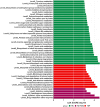Role of tenofovir dipivoxil in gut microbiota recovery from HBV-infection induced dysbiosis
- PMID: 39304810
- PMCID: PMC11414042
- DOI: 10.1186/s12866-024-03457-4
Role of tenofovir dipivoxil in gut microbiota recovery from HBV-infection induced dysbiosis
Abstract
Background: Studies have found dysbiosis of the gut microbiota in individuals infected with the hepatitis B virus (HBV). Tenofovir dipivoxil (TDF) is one of the preferred oral antiviral drugs used for the treatment of chronic hepatitis B (CHB), but the extent to which TDF is able to affect the gut microbiota and inflammatory factors of a patient remains largely unexplored. In this study, we collected stool samples from HBV patients prior to medication and from CHB patients treated with TDF.
Results: The gut microbiota and inflammatory factors were assessed in 42 healthy subjects (HC group), 109 HBV-infected subjects, including 48 CHB patients who were not medicated with nucleoside analogue drugs (No-NAs group), and 61 CHB patients who were medicated with TDF (TDF group). 16 S rRNA sequencing revealed that TDF treatment caused significant changes in the gut microbiota of HBV-infected individuals; however, the gut microbiota of HBV-infected individuals did not fully recover to a pre-dysbiosis state. The relative abundance of Bacteroidota gradually decreased from the HC group to the No-NAs and TDF groups. The relative abundance of Fusobacteriota was significantly higher in the No-NAs group than in the HC group. At the genus level, Dialister, Eubacterium_hallii_group, Halomonas, Collinsella, Sphingomonas, Xanthomonadaceae_unclassified, and Rhizobiaceae_unclassified were overrepresented; while the abundance of Bacteroides and Fusobacterium decreased significantly in the No-NAs and TDF groups.
Conclusions: This study showed that TDF treatment significantly improved the regulation of the gut microbiota and aided in dysbiosis recovery. We did not observe significant improvement in serum inflammatory factor concentrations, which may be related to the relatively short duration of TDF administration in this study.
Keywords: Chronic hepatitis B; Dysbiosis; Gut microbiota; Hepatitis; Tenofovir dipivoxil.
© 2024. The Author(s).
Conflict of interest statement
The authors declare no conflict of interests.
Figures







References
-
- Organization W. Global Hepatitis Report, 2017; 2017.
MeSH terms
Substances
Grants and funding
LinkOut - more resources
Full Text Sources
Medical

